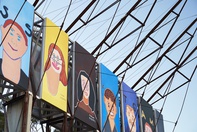Thom Roberts
Sydney
2019
Displayed 2019 at Carriageworks

Thom Roberts
Born 1976, Sydney. Lives and works Sydney
Thom Roberts has a deep personal fascination with trains. He sees them as having their own personalities – they are his friends. More recently his paintings of ‘train faces’ depict the individual characteristics of Sydney’s CityRail models: the Tangara appears to grin at you, while the chic Millennium model peers coolly through its windshield. Roberts also works in performance, video animation, installation and design. He works closely with Studio A, Sydney, to partner with organisations such as Erth Visual & Physical theatre, Sydney, One Another design and Mud Australia, as well as working collaboratively with artist Harriet Body as Thom and Angelmouse.
Artist text
by Carrie Miller
The train is perhaps the quintessential cultural signifier of capitalist modernity. This is not simply because, as a mode of mass-transportation, it is the literal and representational embodiment of modernist notions of human progress; the phenomenological experience of being a passenger embodies a paradigmatic shift in how we have come to view the world. Historically coincident with the advent of cinema, rail transportation offers us ‘the prototypical experience of looking at a framed, moving image’. (1)
From this perspective, it is possible to consider Thom Roberts’ work not only as a creative expression of his obsessive interest in trains, but also as suggestive of the way rail transport enables a cinematic way of seeing. This is apparent in Roberts’ practice of producing multiple images that form a type of sequence – a reminder perhaps of the way the illusion of movement in film is generated by a series of still images. It is also perceptible in his fascination with photocopying found images, sometimes resulting in a blurring effect reminiscent of the experience of looking out the window of a moving train.
But while it is possible to make these larger claims about Roberts’ practice, it’s undeniable that the work is, first and foremost, an extension of his deep and abiding personal connection to this specific form of technology:
I liked trains since I was a little child, reddies and silveries back in those days; 1984 it was. I was counting them. I was counting the trains. I still count them. I see one – one going that way, one going the other way. It’s just something that I like to do. (2)
By this account, Roberts would seem to fit the conventional profile of a trainspotter. But while he may have the esoteric preoccupations, obsessive tendencies and quirky personality traits we associate with trainspotters, there is nothing tedious or banal about Roberts or his art. Spend some time with him or give attention to his work and his fascinations quickly become yours.
Roberts’ ‘portraits’ of ‘train people’ are a captivating expression of his personal taxonomy of the world, where people are categorised in terms of types of trains and in which trains take on human qualities. He’s particularly interested in the contrast between the facial expressions of commuters and the expressions he attributes to the ‘face’ of a train. While acknowledging a spectrum of human emotion on the faces of the travellers he observes – ‘happy, sad, grumpy, thinking, surprised, frustrated, worried’ – Roberts points to the fact that people generally ‘look grumpy when they get off’. By contrast, trains ‘don’t look grumpy, they look happy’.
It’s in this observation that we can understand Roberts’ train-people portraits as reminders of the way in which we become mechanistic in our passive response to the tedium of life, drained of the type of singular passion that he has for his beloved trains.
It is especially meaningful for Roberts to exhibit his artwork on the site of an old rail yard. Carriageworks is not merely an exhibition space for this artist; it’s his rightful spiritual home. As he puts it: ‘I get to go to Carriageworks and see all the trains and count them ... Also, people on the trains will see Thom Roberts’ artwork display ... Thank you!’
Notes
(1) Lynne Kirby, ‘Male hysteria and early cinema’ in Constance Penley & Sharon Wills (eds), Male Trouble, University of Minnesota, Minneapolis, 1993, p.67.
(2) All quotes are from an interview between the artist and author, 15 August 2018.
